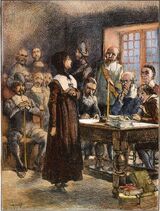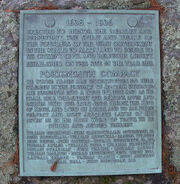Gov John Coggeshall was born 2 April 1601 in Halstead, Essex, England to John Coggeshall (1576-1615) and Anne Butter (1583-1648) and died 27 November 1647 Newport, Newport County, Rhode Island of unspecified causes. He married Mary Gould (1604-1684) 1622 in Halstead, Essex, England.
Biography

Gov John Coggeshall Grave Medallion in Newport RI.
Died in office (1647-1647)
John Coggeshall was one of the founders of Rhode Island and the first President of all four towns in the Colony of Rhode Island and Providence Plantations. Coming from Essex, England as a successful merchant in the silk trade, Coggeshall arrived in the Massachusetts Bay Colony in 1632 and quickly assumed a number of roles in the colonial government. In the mid-1630s he became a supporter of the dissident ministers John Wheelwright (1593-1679) and Anne Hutchinson. When Hutchinson was tried as a heretic in 1637, Coggeshall was one of three deputies who voted for her acquittal. Hutchinson was banished from the colony in 1638, and the three deputies who voted for her acquittal were also compelled to depart.
Before leaving Boston, Coggeshall and many other Hutchinson supporters signed a compact in March 1638 agreeing to form a government based on the individual consent of the inhabitants. They then established the new colony of Portsmouth on Aquidneck Island, also called Rhode Island, in the Narragansett Bay, later one of four towns comprising the Colony of Rhode Island and Providence Plantations.
Coggeshall was once again very active in civil affairs, but a rift in the leadership of the colony caused him and several other leaders to leave in 1639, and move to the south end of the island, establishing the town of Newport. The two towns of Portsmouth and Newport reunited in 1640 under the leadership of William Coddington, and Coggeshall was his assistant until 1647 when the two towns of Rhode Island united to form a common government with the towns of Providence and Warwick, and Coggeshall was elected President of the entire colony of four towns. His tenure was very short due to his death later the same year, but during his administration many excellent laws were established, becoming the legal basis for both the colony and state of Rhode Island.
Early Life
John Coggeshall, the son of John and Ann (Butter) Coggeshall, was born and raised in northeastern Essex, England, being baptized at Halstead.[1] After his marriage he lived four miles (six km) away in Castle Hedingham where several of his children were baptized, and where he was a merchant prior to his emigration.[2][3] In 1632, Coggeshall and his family joined the mass immigration of English Puritans to New England, sailing on the Lyon, the same ship that brought Roger Williams the year before.[4][5]
1636: Antinomian Controversy

In 1636-1638, Massachusetts Bay Colony, this family were Free Grace Advocates (AKA: Antinomian Controversy) which caused great religious and political strife in the colony. It pitted most of the colony's ministers and magistrates against some adherents of the Free Grace theology of Puritan minister John Cotton. The most notable Free Grace advocates, often called "Antinomians", were charismatic Anne Hutchinson, her brother-in-law Reverend John Wheelwright, and Massachusetts Bay Governor Henry Vane. In the summer of 1637 their opponents led by Gov John Winthrop won back political control of the colony. The following trial led to the banishment many of the leaders of this movement.
The Coggeshalls first settled at Roxbury where they were admitted to the Roxbury Church the year of their arrival, and where John Eliot would soon be the pastor.[6] In 1634 Coggeshall moved with his family to Boston where he and his wife were admitted to the church on 20 August,[4] and where they became the next door neighbors of William and Anne Hutchinson.
1637 Portsmouth Compact Signer

Plaque commemorating the Portsmouth Compact 1638-1936
He was one of the signatories of the 1637 Portsmouth Civil Compact founding Portsmouth, Rhode Island, the 2nd settlement in the new colony of Rhode Island. This group, most of were caught up in the events of the Antinomian Controversy from 1636 to 1638, had followed the family of dissident preacher Anne Hutchinson and her family from Massachusetts Bay Colony seeking religious freedom. This document was the first compact to declare both political and religious separation.
1639 Newport Founders
Newport Settlement 1639 was founded in 1639. Its eight founders and first officers were Nicholas Easton, William Coddington, John Clarke, John Coggeshall, William Brenton, Jeremy Clark, Thomas Hazard, and Henry Bull. They left Portsmouth, Rhode Island after a political fallout with Anne Hutchinson and her followers.[citation needed] As part of the agreement, Coddington and his followers took control of the southern side of the island. They were soon joined by Nicholas Easton, who had recently been expelled from Massachusetts Bay Colony for holding heretical beliefs. The settlement grew to be the largest of the four original settlements of Rhode Island, which also included the Colony of Providence Plantations and Shawomett. Many of the first colonists in Newport became Baptists, and the second Baptist congregation in Rhode Island was formed in 1640 under the leadership of John Clarke.
Marriage and Family
Coggeshall's wife was named Mary, but her maiden name remains uncertain. Some sources claim her maiden name is Gould, another says it is Surgis, but these are undocumented, and having examined the evidence, Charles Anderson and the editors of the Great Migration project conclude her maiden name is not known. Coggeshall and his wife had eight children, five of whom were born in England, and the others born in Boston, but only half of whom are known to have survived to maturity.
- John Coggeshall (1624-1708)John, was very active in colonial affairs over a period of three decades, serving as treasurer, commissioner, assistant and deputy governor.
- Their second surviving son, Joshua, also served in public office as deputy to the General Court of Rhode Island for all but two years between 1664 and 1672, and as assistant (magistrate) for all but one year from 1669 to 1676.
- Ann Coggeshall (1626-1688) - their oldest daughter, married Peter Easton (1622-1693), a son of Gov. Nicholas Easton who served many terms as either president or governor of the Rhode Island colony.
- Their other surviving daughter Wayte married Daniel Gould and their descendant Elizabeth Buffum Chace was a known abolitionist with the Underground Railroad.
Children
| Name | Birth | Death | Joined with |
| Joshua Coggeshall (1623-1688) | |||
| John Coggeshall (1624-1708) | 1624 Halstead, Essex, England | 1 October 1708 Portsmouth, Newport County, Rhode Island | Elizabeth Baulstone (1629-1700) Patience Throckmorton (1640-1676) Mary Hedge (1648-1731) |
| Ann Coggeshall (1626-1688) | 7 May 1626 Castle Hedingham, Essex, England | 3 March 1688 Newport, Newport County, Rhode Island | Peter Easton (1622-1693) |
| James Coggeshall (1628-1658) | |||
| Mary Coggeshall (1633-) | |||
| Hananiel Coggeshall (1635-1645) | |||
| Wait Coggeshall (1636-1718) | |||
| Bedadiah Coggeshall (1637-) | |||
Siblings
Legacy and Descendants
Places named for President Coggeshall include John Coggeshall Elementary School in Portsmouth, Rhode Island; Coggeshall Way and Coggeshall Circle in rural Middletown; and Coggeshall Avenue in Newport, which goes through the original Coggeshall property. His numerous descendants include painter Sanford Robinson Gifford and composer Jimmy Van Heusen.[citation needed]
See Also
- John Coggeshall
- Coggeshall in Newport County, Rhode Island
References
- John Coggeshall - Wikipedia